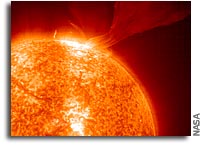Sunquakes Reveal The Solar Furnace

Most people are familiar with the fact that sensitive
instruments known as seismographs can detect earthquakes
taking place many hundreds or thousands of miles away.
By studying the waves from these tremors, scientists
can find out about the conditions deep inside our rocky
planet.
In the same way, astronomers are now able to measure
millions of sound waves that propagate throughout the
Sun, causing it to vibrate or ring like a bell. This
technique, known as helioseismology, is the solar
equivalent of terrestrial seismology.
On Monday 7 April, Dr. John Leibacher (U.S. National
Solar Observatory) will highlight recent results from
helioseismology studies during a presentation to the
UK/Ireland Solar Physics Meeting in Dublin. These will
include new views of the rapidly changing “sub-surface
solar weather” and the far side of the Sun, as well as
prospects for seeing finer and deeper details within
the Sun and other stars.
“Unimaginable 25 years ago, helioseismology today
allows us to ‘see’ into the otherwise invisible
interior of the Sun,” said Dr. Leibacher. “This has
enabled us to overthrow some theories, corroborate
others, and pose many more new questions as we finally
get a glimpse of how things work.
“We are now testing fundamental theories of physics and
astrophysics, substantially advancing our knowledge of
the Sun’s structure and dynamics,” he added. “We are
also beginning to measure significant temporal
variations ranging from the scale of the eleven-year
solar sunspot cycle right down to ‘solar weather’
variations on the scale of a day.
“Recent observations have been producing some remarkable
results on flows of gas that we can image below the
surface of the Sun. For example, we are now seeing
strong subsurface winds flowing into groups of sunspots,
which change from day to day. These sunspots are the
sources of the strong magnetic fields which give rise
to explosions on the surface. These, in turn, produce
all sorts of terrestrial effects, from the aurora
borealis, to fluctuations in navigational satellite
signals, to power outages, and in the longer term they
may influence Earth’s climate.
“With the discovery of these flows, we may be getting
close to understanding the real nature of sunspots,
with the tantalising prospect of being able to predict
their occurrence. We can already utilise helioseismic
imaging to detect sunspot groups on the far side of
the Sun, before they rotate onto the visible hemisphere.
“It has been an exhilarating ride and we are excited
to see what the next turn will reveal,” he said.
Notes for editor
Helioseismology is the study of “Sunquakes”. By observing
the properties of pressure waves that propagate
throughout the Sun’s interior and appear at its visible
surface, scientists can measure the internal structure
and sub-surface “weather” of this otherwise inaccessible
physical laboratory.
These vibrations are seen as the Doppler shifting of
light emitted at the Sun’s surface with periods near
five minutes. Just as we hear the pitch of a police
car’s siren change when it moves towards or away from
us, so sensitive ground- or space-based instruments
are able to determine the motion of different parts
of the solar surface. Modern observatories can detect
relative motions of a few cm/sec on the Sun, which is
150,000,000 km from the Earth.
Worldwide networks of ground-based telescopes (one of
which is based at the University of Birmingham in the
UK) conduct a detailed study of solar internal
structure and dynamics by obtaining nearly continuous
observations of the Sun’s five-minute pulsations. Other
observations are made with the ESA-NASA SOHO spacecraft.
One of the additional advantages of such 24-hour-a-day
solar observing is that phenomena such as the very rare
transit of Mercury across the Sun in May 2003 should
be visible in its entirety, although the transit will
finish just at sunrise in the UK.
Dr. Leibacher is the director of the Global Oscillation
Network Group programme, with sites in California and
Hawaii, Western Australia, Rajasthan (India), the
Canary Islands and La Serena (Chile). He is also
Chair of the Solar Physics Division of the American
Astronomical Society.
FURTHER INFORMATION AND IMAGES CAN BE FOUND ON THE WEB AT:
* Solar subsurface weather.
http://lcd-www.colorado.edu/solar-storms
* Solar farside imaging.
http://www.colorado-research.com/~dbraun/farside-gong
* Transit of Mercury across the Sun in May 2003.
http://sunearth.gsfc.nasa.gov/eclipse/OH/transit03.html
* Global Oscillation Network Group.
http://gong.nso.edu









